May 8 2017
Sunday: Masters Racing in Piestany
Three races for me this Sunday. First, a mixed quad sprint (500m) at 9:35. Followed by what I considered to be the main event, the Masters C single, over 1000m, at 10:50. And finally the Masters C double at 13:50.
Masters Mix 4x-
I didn’t know about my start in the mixed quad until Saturday morning. It turns out the local team had been training this discipline, and had written up names of participants from other clubs to create some opponents. So on Saturday morning I discovered my name in the regatta program and my quad partners. Luckily we had a quad on our trailer. I rowed with Michal (the trainer of the boys), my wife Romana, and Michaela from the rowing club in Uherske Hradiste. We were up against the local team from Piestany and a mixed quad from Uherske Hradiste.
I am afraid we messed up the start a bit. We had done some pretty good practice starts during the warming up for the race, but we were not aligned when the referee announced (in Slovak) that he would start the race from the launch and that he would start immediately. As the stroke rower, I still had my blades flat on the water when the starter said “Attention”, and we definitely missed half a stroke.
Half a stroke is quite a lot on a 500m sprint on a fast flowing river. As was proven about 1 minute and 20 seconds later, when we crossed the finish line half a stroke behind the winning Piestany.
I had tried hard. The stroke rate had been in the high 30s for the entire minute and a bit, and my legs were exploding, but it wasn’t enough.
Masters C/D 1x
On to the main event. The Masters singles races were divided in two finals, one with the younger “A” and “B” rowers, and one with three “C” rowers and one “D” rower. In principle, I should win this race.
A few minutes before I wanted to launch, I was fiddling with my SpeedCoach and the single, when it started to rain. I turned around the single in the slings and reached our tent just in time before it started to rain really hard. I saw some of my competitors rowing to the start in the heavy rain. I checked the sky and decided to wait until the rain had completely stopped. It shortened the time before the start a bit, but there was still some reserve, and I figured it was better to arrive at the start line dry and not with a boat filled with water.
For me, the race was an experiment. With the power meter in the boat, I was torn between just rowing my usual race and trying to adhere to a certain power number and trying to flat pace. I guess the end result was a hybrid, but it was interesting.
The “ideal” pace was to row somewhere between 320W and 340W average on the SpeedCoach, 32spm, and try to ignore the other rowers.
I was second out of the start, with the guy from Bratislava a length ahead.
It is very hard for rowers to ignore other rowers in such a race situation. There is nothing better than being the first out of the start and to look at the competitors.
Still, I decided to go to slightly above sustainable pace (350W) but not much higher. So I ended up rowing about 400m behind this Bratislava guy, and then I finally started to move. Looking at the pace values in hindsight, I didn’t really speed up, but he was slowing down. During the race, I could also see that from the Power value, and I must say it was quite a nice feeling to hold 320W and see that I gained on him with every stroke. The passing took about 15 to 20 strokes. Then I was ahead of him and I decided to continue at 32-33spm and trying to hold 320W.
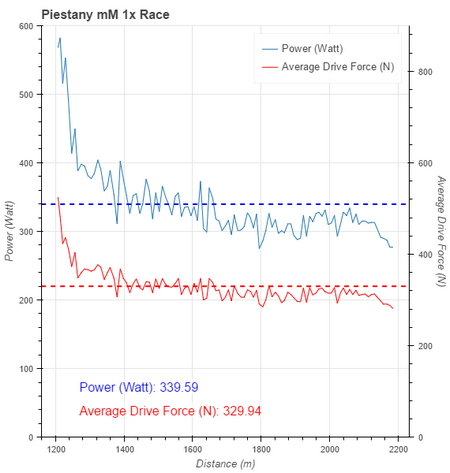
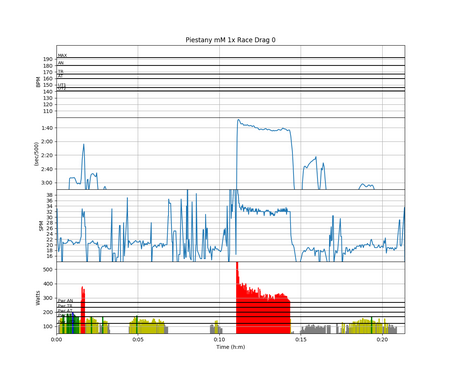
You can see from the power plot that I actually reduced the Power a bit after I had passed the competitor. I think it proves that going out too fast is a bad tactic.
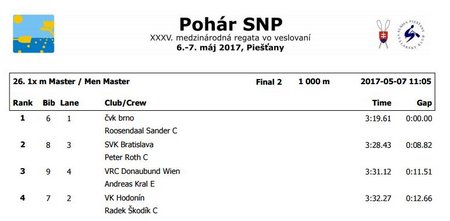
That was a fast 1000m! Actually, it equals my erg PB. With a big help from the river Vah of course. Third win in a row for me in this race. I will do some detailed analysis in another blog post.
Masters C 2x
I spent the time between the singles race and the start of the doubles organizing a doubles partner. Originally, I was scheduled to row with the Boys trainer Michal, but his boys had a lot of starts around the 2x event, so he preferred to not row it. Finally, I found a guy from the Breclav rowing club wanting to row with me. I went around telling the main competitors so they wouldn’t be surprised and all was fine.
We took one of our club 2x boats, and I was surprised how low it was rigged.
Our main competitors were the double of Marko Milodanovic and Andreas Kral. Marko had won his singles race in a time 8 seconds faster than I. Kral and my partner Antonin were equally fast with 3:31. But of course Marko and Andreas train together regularly.
We rowed next to them for the first 500m. Then we got hit by a big wake, and the Austrians did a better job of rowing through it. In the final 200m we were trying to fight off Bratislava who were taking over. In the end they got us by 0.5 seconds.
After that it was time to help the coaches with their teams and to start preparing the trailer for the trip home. Around 3pm the “packing panic” started, which was worse than normal, because we were traveling with a lot of newby kids who didn’t know the drill, so boats arrived at the trailer in the wrong order, which created a traffic chaos, because the trailer parking was also the main through road from the race venue to the town.
I was glad when I could wave the trailer goodbye and get to my bike. We cycled back to our hotel. Romana and I took an hour of sauna and steam bath, and then we had a nice dinner. Monday would be a holiday, so we didn’t have to travel home immediately after the races.
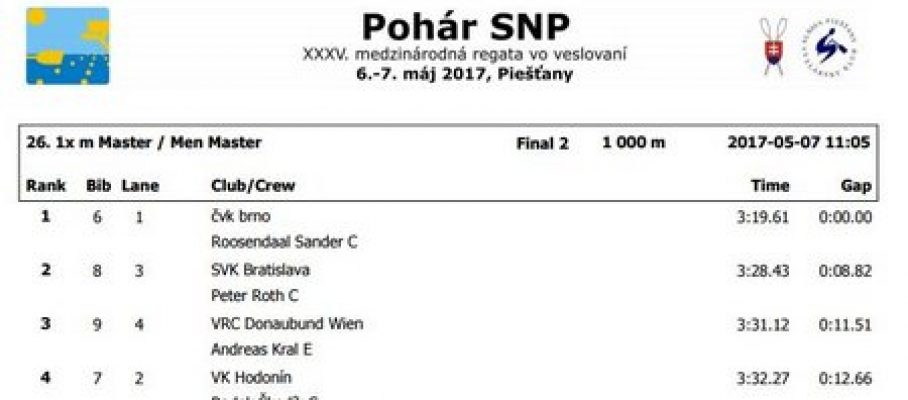
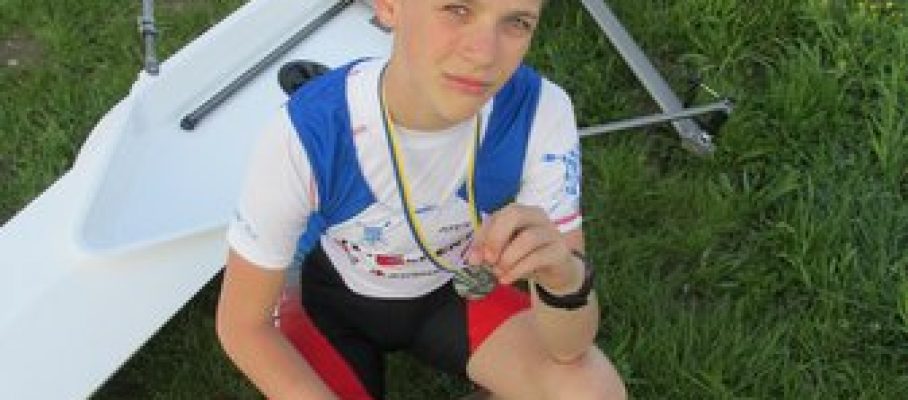
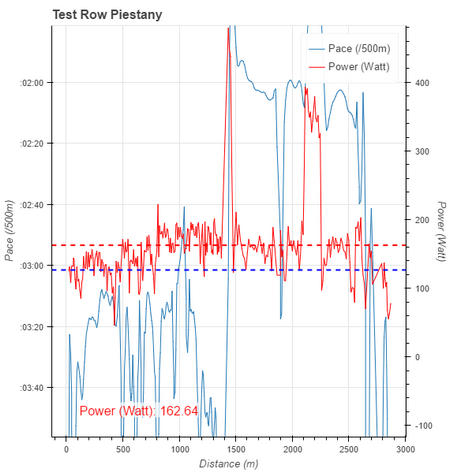
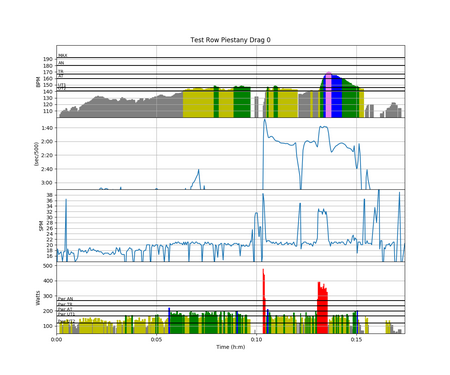

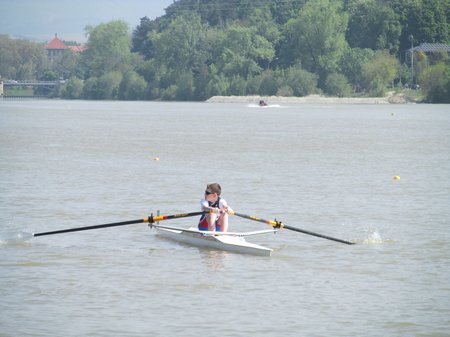
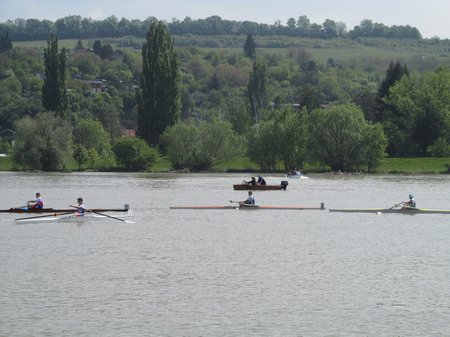
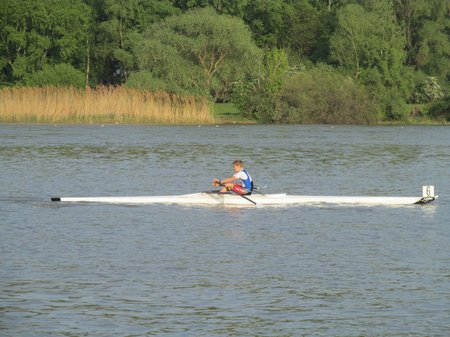
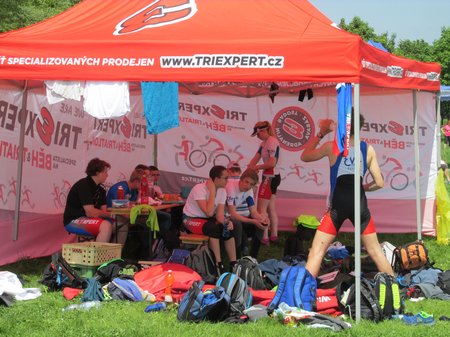
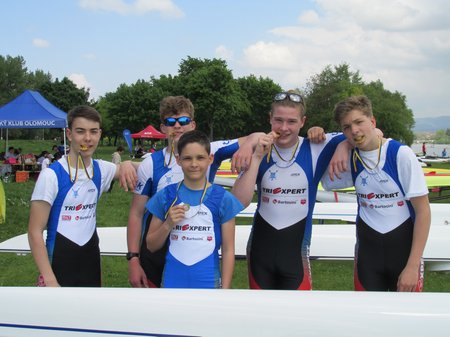
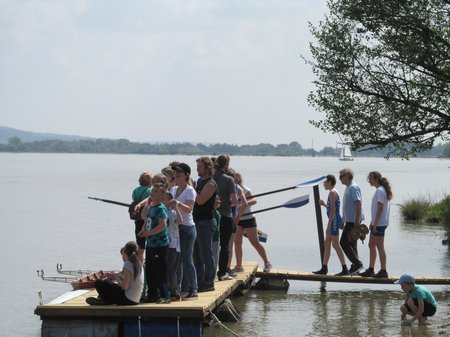
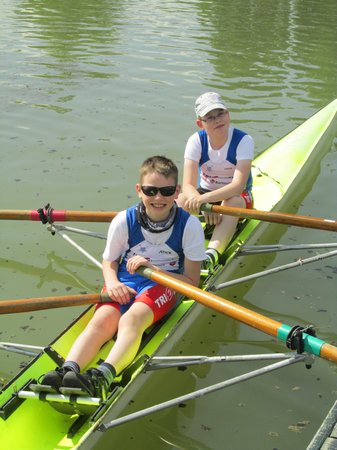
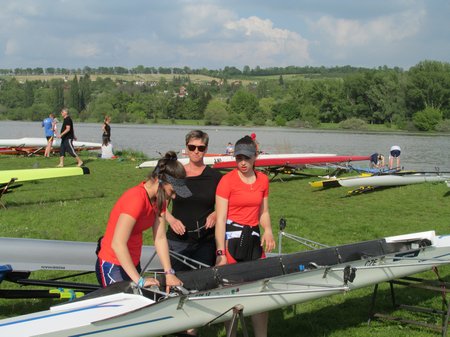
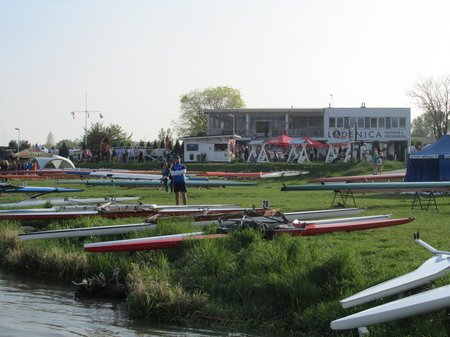
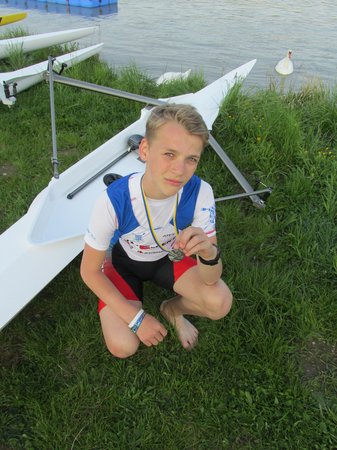
May 8 2017
Stroke Analysis of my 1000m singles race
Race Analysis
In this post I am looking at a few detailed metrics of the Masters 1x 1000m race I rowed yesterday. Data were collected with a SpeedCoach GPS 2 combined with a NK Empower Oarlock.
Here is the overview plot of catch and finish angles for the entire outing, including warming up and cooling down. The actual race starts at 1200m. Interesting to see that I seem to suddenly take length about 400m before the finish line. This is exactly the point where I finally passed my opponent and actually started to row at a lower power.
Here is a close-up of catch and finish angle for the race segment. We’re talking a 1 degree difference, but still it looks pretty consistent and significant.
So here is the power and average drive force. The start strokes are always at high power and force, as you are starting from a stop and rowing short strokes at high rate. I think I did a pretty good job getting the average force down to an average value and holding that for the rest of the race. It is interesting to see the power drop about half way, while the drive force remains constant, and the catch angle actually increases. That means that I either started to row at a lower stroke rate, or the actual stroke was shorter despite the catch angle being longer.
The plot thickens when we look at the “Work per Stroke” which drops with the drop in power. So it looks like the stroke rate remained constant, but something else was changing.
Funny enough, both the absolute drive length and the effective drive length remain constant for the entire race and at pretty good values. So the shift in catch angle was actually me focusing on length (after I had passed my opponent) and tap-down (which makes the stroke slightly shorter at the finish). Should be visible from Wash values.
Looking at Wash and Slip values, I cannot see a big difference:
Finally, the solution to the riddle seems to be the Peak Drive Force:
Interesting! I hadn’t expected that. The stroke profile plot for the first half of the race:
And here is the second half of the race. Almost identical to the first half, but the tiny difference do lead to a drop in power, while my pace didn’t drop as much as that of my opponent.
Here are power and pace in one plot:
And finally, stroke rate and power:
Monday – Tourism and travel home
Today was a holiday, so we made a few stops on the way home. Here are a few pictures:
This slideshow requires JavaScript.
By sanderroosendaal • Uncategorized • 0 • Tags: OTW, rowing, rowing analytics, single